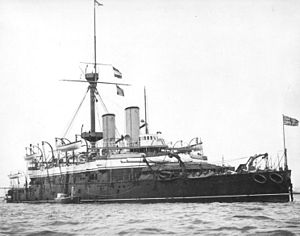HMS Rodney (1884)
 |
|
| History | |
|---|---|
|
|
|
| Name: | HMS Rodney |
| Namesake: | Admiral George Brydges Rodney |
| Builder: | Chatham Dockyard |
| Laid down: | 6 February 1882 |
| Launched: | 8 October 1884 |
| Completed: | June 1888 |
| Fate: | Broken up, 1909 |
| General characteristics | |
| Class and type: | Admiral-class battleship |
| Displacement: | 10,300 tons |
| Length: | 325 ft (99 m) pp |
| Beam: | 68 ft (21 m) |
| Draught: | 27 ft 10 in (8.48 m) |
| Propulsion: |
|
| Speed: |
|
| Complement: | 530 |
| Armament: |
|
| Armour: |
|
HMS Rodney was a battleship of the Victorian Royal Navy, a member of the Admiral class of warships designed by Nathaniel Barnaby. The ship was the last British battleship to carry a figurehead although smaller ships continued to carry them.
She was a development of the design of Collingwood, but carried 13.5-inch (342.9 mm) calibre main armament as against 12-inch (304.8 mm) in the earlier ship. This necessitated an increase of some 800 tons in displacement, and an increase of some 18 inches (46 cm) in draught. This in turn produced a significant increase in the immersion of the armour belt, which was further increased when the coal bunkers were full. While this meant that under full-load condition the top of the belt approached the water-line, the view was taken that combat with a heavily armed enemy was very unlikely in the immediate vicinity of a British port, and steaming to a more distant potential battleground would use enough fuel to reduce the draught and bring the top of the belt well above water.
The main artillery fired a shell weighing 1,250 pounds (570 kg), which would penetrate 27 inches (690 mm) of iron plate at 1,000 yards (910 m). They were carried some 20 feet (6.1 m) above the water line, and each had a firing arc of 270 degrees. The manufacture of these guns took a much greater time than had been expected; this delay was the reason for the unusual prolongation of the time between the laying down of the ship and her completion.
During a refit in 1901, her 6-pounder quick-firing Hotchkiss guns were substituted with 6-pounder quick-firing mark I Nordenfelt guns.
She was commissioned on 20 June 1888 into the Home Fleet. She was held in reserve until July 1889, and after taking part in manoevres until September she served with the Channel Fleet until May 1894. She was then posted to the Mediterranean, remaining there until 1897. Thereafter she was coastguard ship at Queensferry under the command of Captain Gerald Walter Russell until February 1901, when she sailed to Chatham for a refit. She remained in reserve until being sold in 1909.
...
Wikipedia
